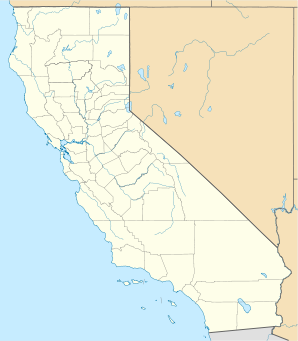Portola
| Portola | ||
|---|---|---|
|
Location in California
|
||
| Basic data | ||
| Foundation : | May 16, 1946 | |
| State : | United States | |
| State : | California | |
| County : | Plumas County | |
| Coordinates : | 39 ° 49 ′ N , 120 ° 28 ′ W | |
| Time zone : | Pacific ( UTC − 8 / −7 ) | |
| Residents : | 2,227 (as of: 2000) | |
| Population density : | 384 inhabitants per km 2 | |
| Area : | 5.8 km 2 (approx. 2 mi 2 ) of which 5.8 km 2 (approx. 2 mi 2 ) is land |
|
| Height : | 1480 m | |
| Postcodes : | 96122, 96129 | |
| Area code : | +1 530 | |
| FIPS : | 06-58352 | |
| GNIS ID : | 1659425 | |
Portola is a city in Plumas County in the US state of California . It is the county's only incorporated city , although the county seat is located in Quincy , about 50 km away . The city is named after Gaspar de Portolà , a governor of California during the Spanish colonial era .
location
Portola is located in the Sierra Valley , the largest alpine valley in the Sierra Nevada , at the central branch of the Feather River and has, according to the census of 2000 2227 inhabitants. The city itself extends over an area of 5.8 km² . It is accessed by the California State Highway 70 , the Feather River Route of the Union Pacific Railroad runs through the valley and the village.
history
The region was originally sparsely populated by Maidu and Wahoe Indians . In 1850, James P. Beckwourth , a trapper and fur trader , explored a road for gold prospectors and pioneers through the Sierra Valley , later known as the Beckwourth Trail , and built a trading post with a small ranch and hotel around ten kilometers east of today's town, from which today's Beckwourth settlement emerged . In the years that followed, woodcutters began to use the forest in the region.
To improve the removal of the wood felled in the area, the Sierra Valley and Mohawk Valley Railroad began work on a narrow-gauge railway line through the Sierra Valley in 1885 to connect Reno , Nevada, east of the mountains, with the Sierra. In 1894 and 1903 the line was extended to the west and a small railway depot was set up in the area where it is today. In 1910, Western Pacific Railroad built a standard gauge railway line from Sacramento through the Sierra along the Feather River through Portola, the narrow-gauge line was abandoned shortly afterwards. Western Pacific also set up a plant in Portola.
In 1905, Nevada lumberjacks who worked in the region built their central camp around the depot and named it Headquarters . Shortly afterwards, more lumberjacks came from Utah and renamed the settlement, which now has over 100 residents, Mormon Junction . In 1908 the larger settlement was renamed Imola again. Several sawmills emerged in the area of the city, which was named Portola in 1910.
With the woodcutters and the train came other inhabitants who used the fertile high valley for agriculture. A hotel, shops, saloons and a first school followed. The water supply was built in 1910, electricity in 1915, a high school in 1921. The first newspaper, the Portola Gazette , appeared from 1910 to 1912 , and the Portola Sentinel was founded in 1916 , which in 1917 became the Portola Reporter , which is still published today.
tourism
The city is home to the Western Pacific Railroad Museum. It preserves the depot as it was in the 1950s and 1960s, when it was a typical small BW for diesel locomotives . Over 30 mainline and shunting locomotives as well as more than 80 passenger and freight cars are on display in the museum on around 15 hectares. Almost all vehicles can be climbed and explored by visitors.
Sons and daughters
- Richard Poe (born 1946), film actor
Web links
Individual evidence
- ↑ Unless otherwise stated, this chapter is based on: City of Portola: History of Portola ( page no longer available , search in web archives ) Info: The link was automatically marked as defective. Please check the link according to the instructions and then remove this notice.
- ^ Western Pacific Railroad History Society: Feather River Rail Society Information
